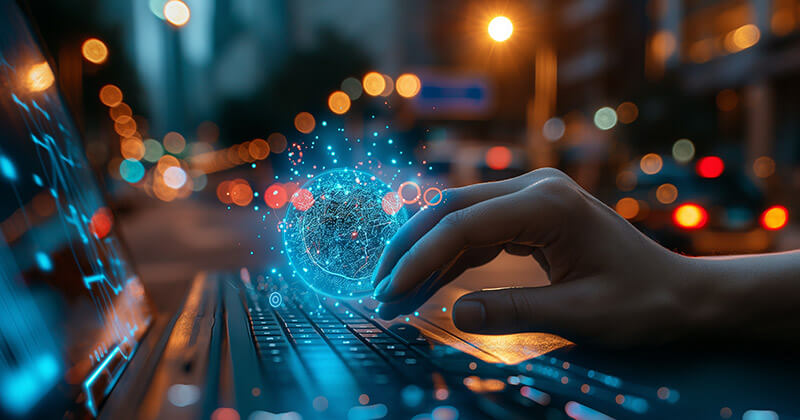Could Disappearing Author Photos in Google SERPs Signal Coming Author Rank?
When John Mueller announced Google was “simplifying the way authorship is shown in mobile and desktop search results, removing the profile photo and circle count,” he asserted that this change was simply an effort to de-clutter the search engine results page (SERP). Prominent Internet marketers, however, had their own theories on Google’s latest bold move.
Here we evaluate some of the theories posed by industry thought leaders about why Google has cut author photos from SERPs. We also explore how the removal of author photos from SERPs may actually portend Google’s intent to add author reputation as an algorithmic ranking factor.
Background on Google Authorship and Author Rank
First, a refresher on the Google Authorship program and when to apply authorship code to a web page.
 The only place authorship markup should appear is on pages that offer educational, unique or otherwise useful information, created by a true author. Authorship markup should not appear on product pages, for example. Think of a magazine — bylines don’t belong on advertisements; they belong on articles. Google has historically used authorship markup to create a special display, or rich snippet, in its search results that may include an author’s name and head shot.
The only place authorship markup should appear is on pages that offer educational, unique or otherwise useful information, created by a true author. Authorship markup should not appear on product pages, for example. Think of a magazine — bylines don’t belong on advertisements; they belong on articles. Google has historically used authorship markup to create a special display, or rich snippet, in its search results that may include an author’s name and head shot.
For more on what Google authorship markup is and how to correctly implement it on a website, read Claiming Your Authorship on the Web.
It’s also necessary to understand how Google may now or eventually use an individual author’s reputation as a ranking signal. Author Rank is industry jargon for an algorithm that gauges the authority of an author so that higher rankings can be given to content written by more authoritative authors. This concept is called “Agent Rank” in one Google patent for a system that quantifies author authority.
Google confirmed that author authority was a ranking signal within In-Depth Articles results. It’s not known if author reputation is used as a ranking signal in other contexts, but there has been indication from Google reps that the search engine would like to use author authority in appropriate contexts if it can be trusted as a clean signal — that is, if the ranking factor can’t be easily spammed.
Abuse of Authorship Markup
Since Google authorship photos debuted in 2011, there have been many reports of increased click-through rates (CTR). A Catalyst Search Marketing case study, for example, found SERP results with author photos saw a 150% CTR increase.
History has shown that known ranking signals become targets of spam and abuse. Ecommerce sites have inappropriately implemented authorship markup on product pages that don’t qualify as “authored” content.
In December 2013, Matt Cutts announced a change that would reduce the appearance of authorship photos in SERPs by 15 percent. This was likely motivated by Google’s interest in cleaning up the signal, weeding out unauthoritative and inappropriate authorship markup. Some have theorized that the latest removal of author photos altogether can also be viewed as a move by Google to stop abuse of authorship markup.
“Google has a vested interest in eliminating people who are using authorship markup just to get their picture in SERPs for an enhanced CTR — people who aren’t really authors or interested in writing true content,” said Bruce Clay, Inc. Senior SEO Analyst Rob Ramirez. “Now that Google has removed photos, i.e., the reward, we’ll see a cleaner SERP.”
In a nutshell, by removing the incentive to abuse authorship markup, Google may be moving closer to using author authority as a ranking factor.
Consider also how Google has experimented with including photos and bylines and a mix of not having one or the other. Google has been selective when including photos and bylines, not always including author bylines despite proper authorship markup implementation. Yet, since Google removed photos completely, we now see author bylines in SERPs consistently. That is, while author photos have been removed altogether, we can now trust that bylines will show up (where authorship markup is set up). Before, it was up to Google’s discretion whether a result would be enhanced with any author info.
Noted Google-authorship expert Mark Traphagen reported:
“Qualification for an authorship byline now is simply having correct markup. This was a bit of a surprise given Google’s move last December to differentiate and highlight authors with better quality content who publish on trusted sites. But in a Google Webmaster Central Hangout on June 25, 2014, John Mueller indicated that now as long as the two-way verification … could be correctly read by Google, a byline would likely be shown.”
With the return of bylines for all authors and the removal of authorship photos, it seems like Google is experimenting with authorship rich snippets as it moves toward an increased emphasis on authorship and a fully realized Author Rank.
Ramirez expects that moving forward, SEOs will continue to see changes within authorship:
“The next thing that we might see Google do is clean up those authors who aren’t really publishing content. How often someone publishes content might start to become a factor. If, for example, authorship is set up one time and it hasn’t budged since that date, that might indicate to Google that this ‘author’ is not, in fact, a real author. In such cases, the user might lose any kind of benefit of authorship. Now that they’ve gotten rid of the photo enhancement in the SERP, they have the problem of cleaning up the people that were spamming it before. That has to be a next step before they go to Author Rank.”
Did Google Remove Author Photos Because the Images Competed with Ads?
On the day of Mueller’s announcement, noted search industry speaker Rand Fishkin (of SEO tools company Moz) tweeted: “the compelling explanation for Google removing profile pics from search is that it distracted from ads, and cost advertisers clicks” and that he was “frustrated [by John Mueller] saying that it will not cost CTR. Either Google lied about the increase in CTR with photos, or they’re lying now.”
In his announcement regarding the removal of authorship photos, Mueller said experiments indicated that CTR would remain steady despite the change to the SERP. Fishkin was not alone in his disbelief; Larry Kim of search advertising software company WordStream tested the theory by turning to analytics data. By his analysis, the CTR of a WordStream ad targeting “negative keywords” gained a 44% increase after the removal of author photos.
“We tested this data rigorously, and the difference we observed is statistically significant with 99% confidence due to the high number of daily ad impressions (thousands) for this keyword,” Kim wrote. “It’s clear to us that based on this data, it’s not realistic to say the deletion of Google authorship photos has no impact on the CTR of other elements on the SERP.”
Even if the removal of authorship photos impacts CTR on ads, Ramirez doesn’t think ad revenue was Google’s main catalyst for this change.
“Things are rarely that black and white when it comes to Google’s motives. I don’t think that Google is hurting for money — they don’t need to make those kind of decisions,” Ramirez said.
Instead, Google’s motivation is most likely tied to improving results and encouraging a cleaner signal for author authority. In the following video, Ramirez shares more of his thoughts on the changes in Google authorship in an exclusive interview:

12 Replies to “Could Disappearing Author Photos in Google SERPs Signal Coming Author Rank?”
Thanks for the second part of this article http://www.bruceclay.com/blog/what-is-clearvoice-author-rank-score/#comment-224699
Please read it
Can we simply say that it was another failed attempt at conquering social media?:) Basically search engine results page should be more about content and not what you look like. But I am curious if authorship photos were actually cannibalizing paid ad clicks… Hmmm!
I’m not sure that I agree that they are refusing authorship for any reason besides to de-clutter SERP as they said. From a consumer’s perspective, I like the idea. From someone in the business though, it’s important to credit authorship. Thanks, Kristi.
This is Good one! Really many webmasters would have confused about removal of Google authorship photo from SERP. But, I would say- this is right move by a ‘big G’ because one of the reason as you’ve mentioned in this post, it wouldn’t be trusted result with author photo and next reason is ‘Brand’ that means brand couldn’t use photos for google authorship -you’ve explained this clearly! Thanks for the share :)
Nice one here, Kristi….have blogged about what I think is the modification of Hilltop vs AuthorRank myownself…and have linked here to your piece on same…there’s something “going on” with AR…and it’s nice to see some of us trying to delve deeper, eh! :-)
I agree with Rob Ramirez, I used to see many low quality articles with author photos in SERP. As far as CTR is concerned, I have mixed results, some of my clients websites have no change in CTR while for others there was a slight decrease in CTR.
The graphical image of the ctr before and after the removal of authorship photos speaks volumes – i kinda was a bit bemused by the whole saga of Google removing the photos – but know I begin to understand why they did. Thanks Kristi.
We have seen a large drop in CTR since Google removed author photos. I think that it was allowing smaller operations to get more clicks because many big brand don’t/cant use an author for their content.
It’s so frustrating, I try very hard to stay on top of all the latest SEO information, not to game the system, but so my content can be found. I finally got all my authorship details correct and my profile picture only displayed for about a month. In the Real Estate space it is so difficult to compete with the big guns like Zillow. The authorship profile was the first opportunity in a long time for a person creating their own website content to stand out.
Hi Roianne,
Maybe this can help you — it’s an article on that I wrote in May, and it breaks down 7 ways a realtor can earn traffic and leads. The photos might be gone, but there are other ways to stand out: http://www.bruceclay.com/blog/real-estate-seo/
Happy reading!
Kristi
LEAVE A REPLY










